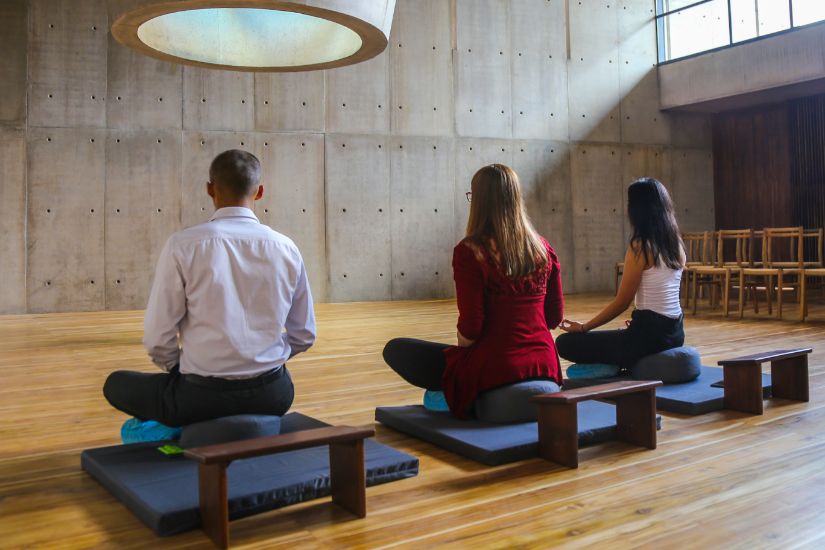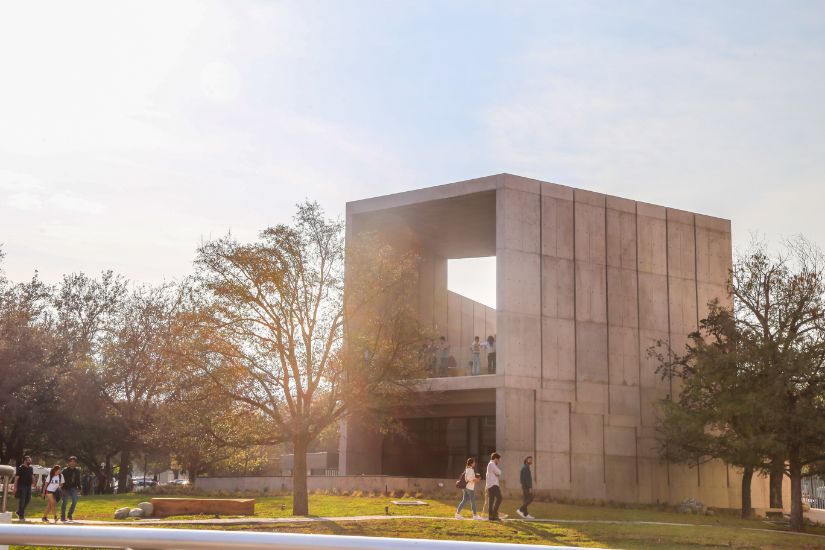For several months now, I have intended to write about Punto Blanco, one of the least known but, in my opinion, most significant areas of contemporary education at Tecnologico de Monterrey. Initially described as a Space of Silence and Reflection, it was conceived by the philosopher and theologian Martha Eugenia Sañudo Velázquez, who, upon arriving at Tec de Monterrey (as she relays the story), missed the presence of a space for ecumenical spiritual development, i.e., inclusivity of all types of beliefs and religions and connected with art and culture. In 2014, she recalls, “… I shared my concern with the then-Rector David Noel Ramírez Padilla and Eva Gonda Rivera, the wife of Eugenio Garza Lagüera.*** Both were enthusiastic about the project and offered their invaluable support. On February 15, 2017, Punto Blanco officially opened its doors.”
I especially like the word enthusiasm in its etymological sense, although it is rarely applied that way. According to a dictionary that I find serious and interesting, originally, enthusiasm is the mood of one who “carries a God within:” an “inner fervor” that seems to come “from some force superior to ours.” Did this definition characterize the enthusiasm that Martha saw in the Rector and Doña Eva Gonda? Probably. The truth is that after those first talks, construction began on Punto Blanco on a site on the Monterrey campus. Although it does not meet the qualifications of a temple, it can be considered more than a building.
Less than a year ago, I visited it, invited by Eloísa Heredia, the current National Director of Punto Blanco. She had read my writings in The Observatory and, identifying with me, encouraged me to offer a talk in that room. When the day came, I traveled to Monterrey and headed to the campus. Guided by Eloísa, we began to tour the campus. I remember the delicious experience of walking amid the hustle and bustle of hundreds of young people and my delight upon discovering the three or four pianos distributed here and there on campus where some kids sit down to play spontaneously. Spirituality was already present.
We strolled the concrete paths winding through meadows and passing by multiple buildings (diverse and stand-alone, as if to honor the unity in diversity that corresponds to all in Uni-versity). I visited the Tree of Brotherhood, a Junipercovered with earth from different states of Mexico and world countries, as a natural monument in which “diversity and brotherhood” are celebrated yearly.
The walk under the royal sun took us to the room where Eloísa would teach her class, “Keys to Happiness for Human Flourishing.” I greeted the students, we did a brief meditation, and I chatted with them for a while before leaving for the site of Punto Blanco.
Designed by the architect Alberto Kalach, the construction is indecipherable at first glance. You have to discover it, first on the outside and then little by little inside the multiple spaces where each room has a breath of intimacy, meditation, and human experience. I especially remember El Refugio, a small and cozy enclosure, isolated from the rest by a thick curtain, where anyone who requests it can go to chat with a spiritual guide, be it a Catholic priest, a Protestant pastor, a rabbi, a Buddhist teacher or whoever of your preference. (Remember the ecumenical character of the project, which, by the way, Eloísa prefers to speak not only of spirituality but of spiritualities, thus consecrating the place to diversity and differences). The heart of Punto Blanco beats beautifully in a wide round space where you can breathe the air of meditation. Above it is El Agora, the chat room with one of its walls open to the sky. (At this moment, I envision Punto Blanco conceived as a human body that communicates with the world through these eyes to the sky.)
*
A soft, deep, and practical woman, Eloisa Heredia runs the place with the patience and dedication necessary to sustain the presence of Punto Blanco amid the bustle of a university more prone to agitation and haste than to spiritual thoughts. As National Director, her mission is also to extend the concept to all Tec de Monterrey campuses throughout Mexico. Several have joined the effort: Mexico City, Santa Fe, the State of Mexico, Sinaloa, Queretaro, Chihuahua, Saltillo, and Puebla. Being part of Punto Blanco does not require allocating a sizeable physical area or investing much: as Eloísa explains, a small site or even a corner in a garden is enough, and the will to bring this unique support to the campus community.
Punto Blanco is part of an academic community; it dialogues with all kinds of knowledge and coexists with all human inclinations and needs. At one level, it is a space where the school community can find a refuge from daily stress, but not just temporarily. Punto Blanco does not aim to be a quick and temporary way out of worries, much less the Tec de Monterrey version of those new devices being installed in some companies so employees take a relaxing break; evidence has shown that this way, they recover and even improve their productivity. No, Punto Blanco was not founded with student productivity in mind. The spirituality sought seeks daily well-being, the reduction of stress and anxiety, concentration, and within all this (why not?), the overcoming of moderate or severe psychosocial obstacles (emotional and mental disorders, for example), but always “from an internal perspective, (from) the construction of one’s meaning, charged with significant emotion for the subject.”

During the visit, Eloísa told me that Punto Blanco and other areas of Tec de Monterrey are conducting a joint investigation for scientific evidence on the positive effects of meditation. The document, National Punto Blanco Deployment: Guidelines and References, is clear about it. “Punto Blanco is pluralistic and simultaneously academic, encompassing a theoretical foundation and finding the spiritual components in all disciplines: the arts, mathematics, languages, and so on.” Theoretical foundation: It signifies an approach that seeks the reasonable and objective; the encounter with oneself without excluding the scientific but rather trying to reduce the gap between all kinds of thoughts and experiences.
Let us admit that sometimes it takes very little to achieve this. I have as an example the practice of mindfulness, which Punto Blanco recommended as part of its support program during the pandemic. Like many other people, in my ignorance, I had always considered mindfulness an exclusively spiritual (even half-pseudoscientific) practice. However, I was recently involved in creating a scientifically rigorous virtual course on opioid use disorders (heroin, fentanyl, and the like), and I was surprised to find the mindfulness technique among the rehabilitation practices. It is a fact that science has already recognized mindfulness as valuable for the development of self-regulation and the recovery and strengthening of coexistence skills.
*
Unlike other practices, spirituality is not exclusive; it is not sectarian. Its fundamentals include engagement with others, generosity, service, and love of neighbor. Therefore, Punto Blanco is not limited to being just another program for Tec de Monterrey members. One of its fundamental objectives is to link it with the communities to which it belongs, starting with the immediate social environments, usually urban. For Tec de Monterrey, Punto Blanco is “an opportunity to link with the cultural and spiritual offerings of the city and include the (external) community.” From what I understand, the activities of Punto Blanco are open to the outside and always promote that approach.
*
The encounter with oneself and the engagement with others comprise two fields of spirituality that Punto Blanco tries to embrace. A third one explained in the document Deployment… “encompasses understanding existence as part of a larger whole. Its subject of interest goes beyond what the senses perceive. In the spiritual realm, life and death acquire a profound meaning that concerns the very origin of human existence and the surrounding whole.” It is clear to me that with this transcendent sense (what is “beyond all possible knowledge,” according to the dictionary), Punto Blanco closes the circle of spirituality and turns this university achievement into a true contemporary innovation.
We are all witnessing a worldwide boom in practices assumed to be “spiritual” by those who perform them. Organizations that offer guidance in developing this transcendent dimension proliferate everywhere. At the same time, science intensifies its materialistic views and distances itself from other ways of feeling and thinking, questioning, without eliminating, the strange fusions created between scientific truths and mystical experiences. On both sides arise wise teachers and false prophets, and the knowledge of our reality tends to polarize without any signs of a possible understanding. In this complexity, the fact that an institution such as Tec de Monterrey opens a space where at least one can reflect is an indescribable advance.
Shouldn’t we bring this reflection back into the classroom? Strangely, educational institutions insist on staying out of a discussion that is already crucial in many families and communities. I propose that numerous topics on spirituality already flowing in the general culture be formally integrated into education under the guidance of experts in all areas (including agnostics and atheists).
In the case of Tec de Monterrey, Punto Blanco would be the ideal coordinator of such an effort, opening its spaces for discussions to flow in an environment of meditation and listening that favors the postponement of personal interests. I am sure that many of us would welcome such news with enthusiasm.
*** Eugenio Garza Lagüera, who died in 2008, was the son of the founder of Tec de Monterrey and its President for life. The Punto Blanco project is dedicated to him.
Translation by Daniel Wetta
This article from Observatory of the Institute for the Future of Education may be shared under the terms of the license CC BY-NC-SA 4.0 
)
)


)